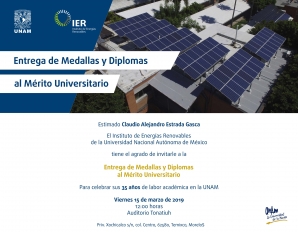Manuel I. Peña-Cruz, Camilo A. Arancibia-Bulnes, Ana Monreal Vidal, and Marcelino Sánchez González.
Abstract
An improved tool for the shape qualification of parabolic trough mirror modules used in concentrated solar power plants was developed. The tool is based on the fringe reflection theory, in which sinusoidal fringe patterns are projected on a screen and their reflection over a specular surface is recorded by a camera. The observed distortions in the image are related directly to surface deviations from ideal geometry. Relevant aspects of the technique are its high spatial resolution (more than 1 × 106 points per mirror facet), short measurement time and easy setup. The developed tool (called FOCuS) is capable of calculating the local mirror slope deviations from its ideal design and the RMS value as a quality factor. Furthermore, the tool generates a file which can be loaded into CENER's TONATIUH ray tracing software, through a specially developed plug-in, for mirror modeling and intercept factor calculation with several tube absorber geometries.
Improving parabolic trough mirror module qualification by FOCuS tool

